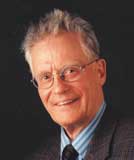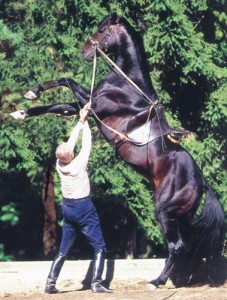Fritz Stahlecker
 Fritz Stahlecker, a textile engineer, born in 1925, lives near the Swabian Alb in Germany. He has worked with horses, often difficult horses, since he was a child and has trained young horses from the beginning to the most difficult dressage movements. He is an inventor of spinning machines (several hundreds of patents) and used to deal with complex correlations. His knowledge taken from various sources of riding literature as well as his long experience of horse schooling made him come to practice and refine a new method of training the very young horse. Influenced by the riding culture in France and Spain especially by the French concept of „Légèreté“, this passionate amateur, who is highly respected among riders – has developed a specific and unusual method: the hand-saddle-hand-method.
Fritz Stahlecker, a textile engineer, born in 1925, lives near the Swabian Alb in Germany. He has worked with horses, often difficult horses, since he was a child and has trained young horses from the beginning to the most difficult dressage movements. He is an inventor of spinning machines (several hundreds of patents) and used to deal with complex correlations. His knowledge taken from various sources of riding literature as well as his long experience of horse schooling made him come to practice and refine a new method of training the very young horse. Influenced by the riding culture in France and Spain especially by the French concept of „Légèreté“, this passionate amateur, who is highly respected among riders – has developed a specific and unusual method: the hand-saddle-hand-method.
 With his method which is based on recent knowledge in the field of modern equine psychology Stahlecker has trained several horses. The most successful was the stallion Weyden, member of the dressage equipe of Germany who under his rider Sven Rothenberger won the silver medal at the Olympic Games 1996 in Atlanta in 1996 and was winner of the bronze medal in the single dressage competition. Many riders nowadays practice this method and the results are impressive and convincing.
With his method which is based on recent knowledge in the field of modern equine psychology Stahlecker has trained several horses. The most successful was the stallion Weyden, member of the dressage equipe of Germany who under his rider Sven Rothenberger won the silver medal at the Olympic Games 1996 in Atlanta in 1996 and was winner of the bronze medal in the single dressage competition. Many riders nowadays practice this method and the results are impressive and convincing.
Th now retired Fritz Stahlecker dedicates his life to promote riding according to the principle of légèreté and methods of schooling horses without force. He writes articles about the development of riding today, about scoring attitutes at competitions, questions concerning riding theory and he fights against schooling methods that are too demanding, physically and mentally, on the horse not yet adult.
Whether riding or painting , for that matter for Fritz Stahlecker aesthetics are the criterion for means and ends.
“It is my goal to motivate horses to cooperate whitout any force. With my hand-saddle-hand-method your horse learns without stress and with the greatest of ease the most difficult dressage movements”
